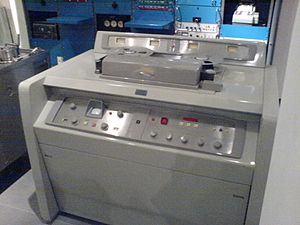Digital Media Concepts/Linear Video Editing
Introduction
[edit | edit source]Linear video editing is a process or procedure that allows videotapes to be modified in the any way; however, it is a process that needed to be executed sequentially. If the edited film were to be edited just in the middle part, the editing process would require the edited film to be cut in half, replace the part, and attach the end. The process includes a variety of features which is capable of editing and arranging images and sounds. The process was prominent until the 1980s when non-linear video editing took over, rendering linear video editing obsolete. However, linear video editing is still used today in some cases, as it is simple and inexpensive.[1]
History & Early Technology
[edit | edit source]
Linear video editing, in this case, film, was first originated during the 1900s when films were cut physically using scissors, tape, and editing tables to be arranged in order as the plot which was a non-linear process. The process was an arduous task since editors were not able to view what they were editing; editors were forced to hold the film against the light to see make their edits.[2] The process of cutting and taping was used until the 1920s until the invention of The Moviola,invented by Iwan Serruier, in 1926. which allowed editors to edit film while at the same time viewing it, but linear meaning that if edits were to be made again, a new copy would be needed to combine the original edit and new edit.[3] The revolutionary innovation made film editing more convenient for editors. Example films editted by The Moviola: L’Age d’Or, The story of a Cheat, Citizen Kane.[4]
Advancements
[edit | edit source]Later in the 1950s, when the videotape recorders were invented by Charles Ginsberg in 1951, the film production shifted to using videotape recorders from film recorders.[5] The videotape recorders allowed videos to be recorded and edited. One of the first videotape recorders was the Ampex Vrx-1000, debuted in 1956, which was later renamed the Mark IV.[6][7] The editing process required using a magnifying glass to zoom in on the magnetic tracks of the tape. The editor would watch both the mark on the tape and the picture at the same time to make the cut though it wasn’t that accurate.[8] However, In 1967, a system, Timecode, was invented which allowed videotapes to be edited, cut, frame-accurately.[9] This method was prominent until the introduction of digitalization.
Usage Today
[edit | edit source]The usage of linear video editing today is unpopular, it remains a big part of the film industry.[10] The process is mainly used editing videotapes in situations for television news programs and delivering film prints. Other uses would include simple video tape edits.[11]
References
[edit | edit source]- ↑ MotionElements. (2021, December 29). "Understanding linear vs non-linear editing". MotionElements. Retrieved March 8, 2022.
- ↑ Donnelly, J. (2022, January 19). "The evolution of video editing: From the Moviola to machine learning". Massive. Retrieved March 8, 2022.
- ↑ "Evolution of video editing". Skillman Video Group. (2022, January 10). Retrieved March 8, 2022
- ↑ Landler, E. (2017, February 16). "Writing with the camera, directing with the Moviola": The American Film Editing Revolution of the late '60s & '70s. CineMontage. Retrieved March 8, 2022
- ↑ Nuwer, rachel. (2013, November 7). "The inventor of videotape recorders didn't live to see blockbuster's fall". Smithsonian.com. Retrieved March 8, 2022.
- ↑ "Ampex VRX-1000 Video tape machine". HistoryOfRecording.com. (n.d.). Retrieved March 8, 2022.
- ↑ "Quad History: From the Debut in 1956 Through the Third Generation of Machines". The Quad Videotape Group. (2014, May 24). Retrieved March 8, 2022.
- ↑ "Videotape is not the only one to progress to extinction! A time and a place story". Evolution. (2007, February 5). Retrieved March 8, 2022.
- ↑ vtoldboys. (n.d.). "museum of Early Video Editing. Museum of early editing equipment and Techniques". Retrieved March 8, 2022.
- ↑ Moviola. (2019, February 6). "Linear editing". Moviola. Retrieved March 8, 2022.
- ↑ Mertz, P. (2016). "motion-picture technology". Encyclopædia Britannica. Retrieved March 8, 2022.
External Links
[edit | edit source]https://en.wikipedia.org/wiki/Moviola
https://en.wikipedia.org/wiki/Iwan_Serrurier
https://en.wikipedia.org/wiki/L%27Age_d%27Or
https://www.criterion.com/films/21815-the-story-of-a-cheat
https://en.wikipedia.org/wiki/Citizen_Kane


